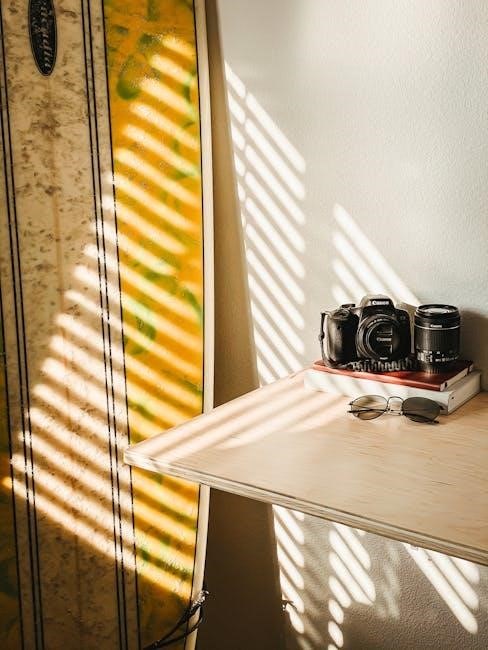Discover how to choose the perfect sunglasses with our comprehensive lens size guide. Proper fit ensures comfort‚ clarity‚ and style‚ making your eyewear experience exceptional and tailored to you.
Importance of Proper Fit
A proper fit is essential for both comfort and functionality in sunglasses. Ill-fitting frames can cause discomfort‚ slipping‚ or limited visibility‚ which can be frustrating. When sunglasses are too tight‚ they may leave marks or cause headaches‚ while frames that are too loose can slip down the nose‚ requiring constant adjustment. Properly sized lenses ensure optimal protection from UV rays‚ reducing glare and improving clarity. Additionally‚ a well-fitting frame complements your face shape‚ enhancing your style and confidence. Measuring your face accurately and understanding frame dimensions are crucial steps in achieving the perfect fit. This guide will help you navigate these details to find sunglasses that feel and look great.
Understanding Frame Measurements
Frame measurements are critical in determining the right sunglasses size. Typically‚ frames are marked with three numbers‚ such as 52-19-140‚ representing lens width‚ bridge size‚ and temple length. Lens width is the horizontal measurement of one lens‚ while the bridge size refers to the distance between the two lenses. Temple length measures the arms of the frame‚ ensuring they fit comfortably around your ears. These measurements‚ often found on the inside of the temple‚ help you compare your face dimensions to the frame. Accurate measurements ensure proper fit‚ preventing slipping or discomfort. Understanding these specs allows you to choose sunglasses that align with your face proportions‚ ensuring both comfort and functionality.

Factors Influencing Lens Size
Face shape‚ personal style‚ and activity-specific needs are key factors in choosing lens size. Proper fit ensures comfort and functionality‚ enhancing your sunglasses-wearing experience significantly.
Face Shape and Lens Compatibility
Face shape plays a crucial role in determining the ideal sunglasses lens size. Round faces benefit from angular or rectangular frames with slightly larger lenses to balance width. Square faces look best with soft‚ curved frames and medium-sized lenses to avoid exaggerating facial angles. Oval faces‚ being versatile‚ can pull off most lens sizes‚ but medium to large lenses complement their natural symmetry. Heart-shaped faces fare well with frames that are wider at the bottom‚ drawing attention downward. Proper lens size ensures a balanced‚ flattering look‚ while mismatched sizes can distort facial proportions. Matching lens size to face shape enhances both style and comfort‚ making it a key consideration in your selection process.
Personal Style and Preferences
Personal style and preferences significantly influence sunglasses lens size selection. Trendy‚ oversized lenses can make a bold fashion statement‚ while slim‚ minimalist designs offer a sleek‚ modern look. Some individuals prefer larger lenses for enhanced coverage and a glamorous appeal‚ while others opt for smaller‚ more delicate frames for a subtle‚ vintage vibe. Lens size should align with your aesthetic goals and lifestyle. For instance‚ those who value simplicity might choose medium-sized lenses‚ whereas fashion enthusiasts might lean toward statement-making sizes. Ultimately‚ your personal style dictates how you balance lens size with frame design‚ ensuring your sunglasses reflect your unique taste while meeting functional needs. This blend of fashion and functionality ensures your eyewear is both stylish and comfortable‚ catering to your individual preferences and enhancing your overall look. Comfort and visibility must also be considered to ensure the chosen size complements your lifestyle and activities‚ making it a crucial factor in your decision-making process.
Activity-Specific Lens Requirements
Different activities demand distinct lens sizes for optimal performance. For sports requiring a wide field of vision‚ such as skiing or motorcycling‚ larger lenses are preferable to enhance peripheral vision. Conversely‚ activities like cycling or running may favor smaller‚ more compact frames for reduced weight and improved mobility. Beachgoers often opt for larger lenses for enhanced UV protection and stylish appeal. It’s crucial to consider how lens size impacts functionality and comfort during specific activities‚ ensuring that your sunglasses meet the demands of your lifestyle while providing the necessary protection and visibility.

How to Measure Your Face
Measure your face using a millimeter ruler or cloth tape. Measure frame width‚ nose bridge‚ and temple length for accurate sunglass fit‚ ensuring the best fit.
Measuring Frame Width
Frame width is crucial for a comfortable fit. Measure horizontally across the temple tips to determine the total width. Ensure the frames align with your face width‚ avoiding excess overhang. Proper alignment prevents discomfort and ensures optimal visibility. Use a millimeter ruler or tape for accuracy‚ matching your face width to the frame size. This step is essential for selecting sunglasses that complement your features and provide a seamless wearing experience.
Measuring Nose Bridge
The nose bridge measurement ensures the sunglasses sit comfortably on your face. To measure‚ place a ruler or flexible measuring tape across the bridge of your nose. Gently press the ruler to find the narrowest point‚ typically between the eyes. Record the width in millimeters. This measurement helps determine the optimal frame fit‚ preventing slipping or discomfort. Most sunglasses have nose bridge sizes ranging from 14mm to 24mm. Match your measurement to the frame specifications for a secure and balanced fit. Proper alignment ensures the sunglasses stay in place‚ providing clear vision and all-day comfort.
Measuring Temple Length
Temple length is crucial for ensuring a secure and comfortable fit. Measure from the temple tip‚ located behind your ear‚ to the hinge near the frame’s front. Use a flexible measuring tape or ruler to gauge this distance accurately; Temple lengths typically range from 135mm to 150mm. Proper temple fit prevents the sunglasses from slipping down your nose or applying too much pressure behind your ears. Ensure the temples align with your natural ear shape for optimal comfort. This measurement‚ often found on the inside of the temple arm‚ helps you select frames that stay in place during various activities‚ ensuring both functionality and style.

Standard Sunglasses Lens Sizes
Sunglasses lenses come in small (40-50mm)‚ medium (50-60mm)‚ and large (60mm+) sizes. These measurements help choose frames that complement face shapes and personal styles effectively.
Small Lens Sizes (40-50mm)
Small lens sizes (40-50mm) are ideal for those with narrower face shapes or who prefer a more discreet look. These lenses are perfect for round or heart-shaped faces‚ as they don’t overpower facial features. Additionally‚ smaller lenses can reduce the “bug-eye” effect‚ creating a more balanced appearance. They are often favored for their sleek‚ minimalist aesthetic‚ which complements casual or formal outfits. However‚ ensure that small lenses provide adequate coverage for UV protection and clear vision. Proper fit is essential to avoid compromising comfort or functionality. Small lens sizes are versatile and suitable for everyday wear‚ offering both style and practicality for various activities.
Medium Lens Sizes (50-60mm)
Medium lens sizes (50-60mm) are the most versatile option‚ offering a balance between style and functionality. They suit a wide range of face shapes‚ including oval‚ square‚ and triangular faces‚ providing ample coverage without overwhelming smaller features. These lenses are ideal for everyday wear‚ offering excellent UV protection and clear vision. Medium sizes are popular for their ability to complement both casual and formal outfits. They are also a great choice for active individuals‚ as they provide sufficient coverage during outdoor activities. Many popular brands‚ like Oakley and Ray-Ban‚ feature medium lens sizes in their collections‚ ensuring a flattering fit for diverse preferences and needs.

Large Lens Sizes (60mm+)
Larger lens sizes (60mm+) are perfect for those seeking maximum coverage and a bold fashion statement. These lenses are ideal for individuals with wider faces‚ offering a proportional fit that enhances comfort and style. They provide excellent UV protection and are often preferred by people who spend extended periods outdoors‚ such as athletes or beachgoers. Large lenses can also serve as a trendy accessory‚ adding a dramatic flair to any outfit. However‚ they may not be suitable for smaller face shapes‚ as they can overwhelm features. Popular brands offer various styles in this range‚ ensuring a balance between functionality and aesthetic appeal for those who embrace larger frames. Proper fit is key to avoiding discomfort and ensuring optimal visibility with larger lenses.

How to Choose the Right Lens Size
Selecting the perfect lens size involves balancing face width‚ personal style‚ and activity needs. Proper fit enhances comfort‚ visibility‚ and functionality‚ ensuring your sunglasses meet your lifestyle demands effectively.
Balancing Lens Size with Face Width
Balancing lens size with face width ensures a flattering and functional fit. Measure your face width across the temples to determine the ideal lens size. For a harmonious look‚ choose lenses that are as wide or slightly wider than your face. For example‚ if your face width is 140mm‚ select lenses around 50-55mm. Avoid frames that extend beyond your temples‚ as they may appear oversized. Similarly‚ lenses that are too narrow can make your face seem broader. Consider your face shape: round faces benefit from angular frames‚ while square faces suit softer‚ wider lenses. Oval faces can accommodate most sizes. Proper balance ensures comfort‚ visibility‚ and a stylish appearance tailored to your features.
Ensuring Comfort and Visibility
Comfort and visibility are paramount when selecting sunglasses. The frame should align with your temple width‚ avoiding pressure points. A well-fitting nose bridge ensures stability without slipping. Ensure the lenses are proportional to your face width to prevent obstructing peripheral vision. Avoid overly large lenses that may cause discomfort or restrict movement. Lighter materials and adjustable temple tips enhance comfort for extended wear. Proper fit prevents sliding‚ ensuring lenses stay aligned with your eyes for optimal visibility. Measure your face dimensions accurately and compare with size charts to find frames that balance comfort and functionality seamlessly. This ensures a pleasant wearing experience while maintaining clear vision and style.
Activity-Based Lens Size Recommendations
When choosing sunglasses for specific activities‚ lens size plays a crucial role in performance. For sports like cycling or running‚ opt for medium to large lenses (55-65mm) to provide maximum coverage and reduce glare. These sizes offer enhanced peripheral vision‚ minimizing distractions. For water activities‚ such as sailing or fishing‚ polarized lenses in medium to large sizes reduce water glare and improve clarity. Casual‚ everyday wear often suits smaller to medium lenses (45-55mm)‚ blending style with functionality. Always consider the activity’s demands—larger lenses for high-intensity sports‚ smaller for casual use—to ensure optimal comfort and visibility. This tailored approach ensures your sunglasses meet your lifestyle needs effectively.

Popular Sunglasses Brands and Their Size Guides
Top brands like Oakley‚ Ray-Ban‚ and others offer detailed size charts to help you find the perfect fit. Use their guides for optimal comfort and style.
Oakley Sunglasses Size Chart
Oakley provides a detailed size chart to help users find the perfect fit. Their sunglasses feature measurements like lens width‚ bridge size‚ and temple length. The first two numbers‚ such as in 52-19‚ represent the lens width and bridge size‚ while the third number indicates the temple length. Oakley suggests using these measurements as a reference but allows for slight adjustments based on frame design. For optimal comfort‚ align the frame width with your face’s temples. Oakley’s chart also considers activity-specific needs‚ offering sport-inspired frames with enhanced grip. Their size guide ensures a balance between style‚ comfort‚ and functionality‚ catering to diverse preferences and face shapes. Visit Oakley’s official website for the full chart and enjoy free shipping on your orders.
Ray-Ban Sunglasses Size Chart
Ray-Ban offers a detailed size chart to help users find the perfect fit for their iconic styles. Their sunglasses‚ like the classic Aviator and Wayfarer‚ come in various sizes to suit different face shapes. The size chart typically includes lens width‚ bridge size‚ and temple length measurements. For example‚ the Aviator model often ranges from 58mm to 62mm in lens width‚ while the Wayfarer can be 54mm to 58mm. Ray-Ban recommends matching your face width to the frame width for optimal comfort and visibility. Use their chart to align your features with the ideal measurements‚ ensuring a balanced and stylish fit. Visit Ray-Ban’s official website for precise details and to explore their collection tailored to your needs.
Other Popular Brands
Beyond Oakley and Ray-Ban‚ other popular brands like Maui Jim‚ Persol‚ and Gucci offer detailed size charts tailored to their unique styles. Maui Jim‚ known for premium lenses‚ provides measurements for frames like the classic “Ho’okipa” model‚ ensuring a perfect fit. Persol‚ famous for its elegant designs‚ includes precise sizing for temples and nose bridges. Gucci‚ blending fashion with functionality‚ offers size guides for trendy frames. Each brand’s chart is designed to match your face shape and preferences‚ ensuring comfort and style. Visit their official websites to explore size options and find the ideal sunglasses for your needs‚ with guidance on lens width‚ bridge size‚ and temple length to enhance your eyewear experience.

Online Shopping Tips
Use virtual try-on tools to visualize frames on your face. Always check size charts for precise measurements. Read customer reviews for insights on fit and comfort.

Using Virtual Try-On Tools
Virtual try-on tools are a game-changer for online sunglasses shopping. These tools use augmented reality to overlay frames on your face‚ allowing you to see how they fit and look. By uploading a photo or using your device’s camera‚ you can experiment with different styles and sizes. This feature is especially useful for understanding how lens size complements your face shape. Many brands‚ like Oakley‚ offer detailed virtual try-ons that simulate the actual fit. This technology reduces the guesswork and helps you make informed decisions. Combine it with size charts and reviews for a seamless shopping experience. It’s a modern solution to the challenges of online eyewear shopping.
Checking Size Charts
Checking size charts is a crucial step in selecting the right sunglasses. Most brands provide detailed measurements‚ including lens width‚ bridge size‚ and temple length. These charts help ensure the frames align with your face dimensions. For instance‚ Oakley’s size guide often lists frames with measurements like 50mm-52mm lens width and 14mm-16mm nose bridge. By comparing these specs to your own measurements‚ you can avoid ill-fitting sunglasses. Look for charts that break down each frame’s dimensions to make an informed choice. This step‚ combined with virtual try-ons‚ significantly improves your chances of finding the perfect fit. Always prioritize brands that offer clear‚ detailed size information for the best results.
Reading Customer Reviews
Reading customer reviews is a valuable step in selecting the right sunglasses. Reviews often provide insights into how a particular frame fits different face shapes and sizes. Many users share details about comfort‚ lens visibility‚ and durability‚ which can help you make informed decisions. Look for feedback on specific features like lens width‚ nose bridge comfort‚ and temple length. Reviews can also highlight common issues‚ such as frames being too tight or lenses being too small. Pay attention to recurring themes and use them to narrow down your options. Additionally‚ reviews from users with similar face shapes or preferences can offer personalized recommendations‚ improving your chances of finding the perfect fit. This step complements size charts and virtual try-ons‚ ensuring a well-rounded decision-making process.
Finding the perfect sunglasses involves understanding your face shape‚ ensuring comfort‚ and using tools like size charts and reviews. This guide helps you make informed decisions for a flawless fit and enhanced style.

Final Tips for Finding the Perfect Fit
To ensure a seamless fit‚ align your sunglasses’ frame width with your face’s temples. Avoid frames that extend too far past your face for optimal comfort and visibility. Use virtual try-on tools to visualize the fit without physical trials. Consider your face shape—oval faces suit most styles‚ while round faces benefit from angular frames. For sports‚ opt for larger lenses with secure temple grips. Check size charts from brands like Oakley and Ray-Ban for reference. Read reviews to gain insights from others with similar features. Balance personal style with functionality‚ ensuring lenses are neither too small nor overly bulky. Measure accurately and prioritize comfort to enhance your eyewear experience.
Importance of Proper Lens Size for Comfort and Functionality
Proper lens size is crucial for both comfort and functionality. Ill-fitting sunglasses can cause discomfort‚ poor visibility‚ and even headaches. Frames that are too wide may slip down‚ while those too narrow can pinch. Ensuring the lens width aligns with your face’s temples prevents the frames from extending past your face‚ maintaining a natural look. Larger lenses offer better coverage for activities like sports‚ while smaller lenses suit casual wear. The nose bridge size must fit comfortably to avoid pressure. Proper sizing also enhances optical clarity‚ as lenses are designed to sit correctly in front of your eyes. Balancing these factors ensures your sunglasses are both stylish and functional‚ providing long-lasting comfort and protection for your eyes. Prioritize accurate measurements for the best experience.
